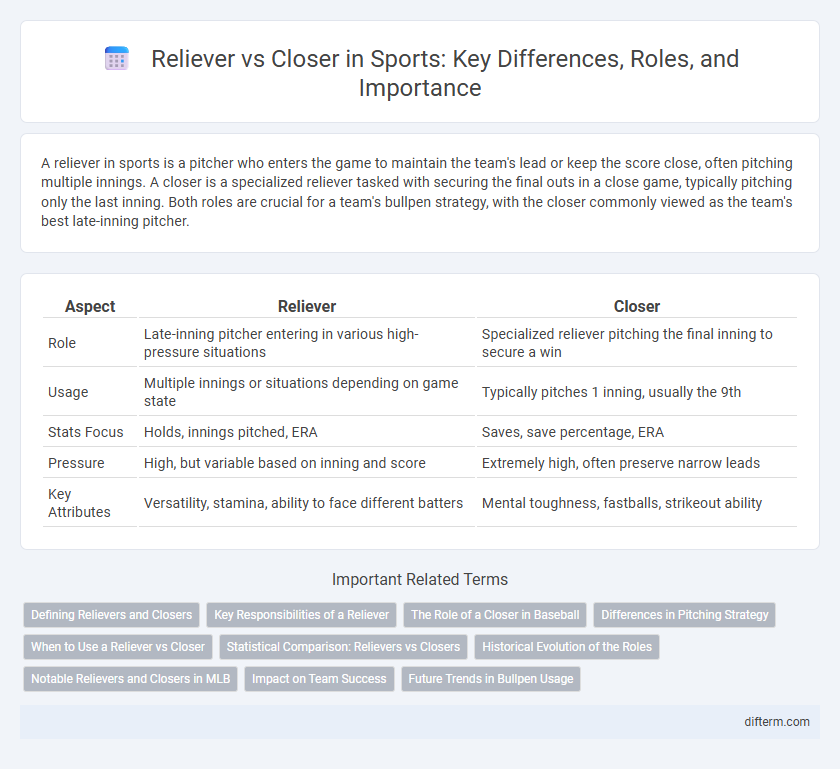A reliever in sports is a pitcher who enters the game to maintain the team's lead or keep the score close, often pitching multiple innings. A closer is a specialized reliever tasked with securing the final outs in a close game, typically pitching only the last inning. Both roles are crucial for a team's bullpen strategy, with the closer commonly viewed as the team's best late-inning pitcher.
Table of Comparison
| Aspect | Reliever | Closer |
|---|---|---|
| Role | Late-inning pitcher entering in various high-pressure situations | Specialized reliever pitching the final inning to secure a win |
| Usage | Multiple innings or situations depending on game state | Typically pitches 1 inning, usually the 9th |
| Stats Focus | Holds, innings pitched, ERA | Saves, save percentage, ERA |
| Pressure | High, but variable based on inning and score | Extremely high, often preserve narrow leads |
| Key Attributes | Versatility, stamina, ability to face different batters | Mental toughness, fastballs, strikeout ability |
Defining Relievers and Closers
Relievers and closers are key pitching roles in baseball with distinct responsibilities; relievers enter the game after the starting pitcher to maintain the lead or keep the score close, often pitching multiple innings. Closers specialize in pitching the final inning, particularly in save situations, focusing on securing wins by preventing opposing teams from scoring. Both roles require strategic deployment based on game context, pitcher strengths, and opposition analysis to optimize team performance.
Key Responsibilities of a Reliever
A reliever's key responsibilities include entering the game to maintain leads or keep the score close during middle or late innings, bridging the gap between starting pitchers and closers. They must quickly adapt to different game situations, often facing multiple batters while preventing runs and preserving team momentum. Effective relievers exhibit versatility, stamina, and the ability to handle high-pressure scenarios, ensuring the pitching staff's overall success.
The Role of a Closer in Baseball
A closer in baseball is a specialized relief pitcher entrusted with securing the final outs of a game, often in high-pressure situations to preserve a lead. Closers typically enter during the ninth inning when the team is ahead by three runs or fewer, demonstrating exceptional composure and pitching skills to prevent the opposing team from scoring. Their effectiveness is measured by statistics such as saves, save percentage, and earned run average (ERA), highlighting their critical role in a team's bullpen strategy.
Differences in Pitching Strategy
Relievers often pitch multiple innings with varied pitch selection to maintain stamina and adapt to different hitters, while closers usually throw one inning with maximum effort, relying on a dominant fastball or signature pitch to shut down the opposing team. The strategic use of relievers involves holding leads in middle innings and setting up for the closer, whereas closers specialize in high-pressure, late-game situations to secure victory. Pitch count management and situational matchups heavily influence relievers, but closers focus on overpowering batters during crucial saves.
When to Use a Reliever vs Closer
Relievers are typically used in middle or long relief situations to bridge the gap between starting pitchers and closers, especially when the game is still undecided or the starter exits early. Closers are deployed in the final inning, usually the ninth, to secure a narrow lead and finish the game under high-pressure scenarios. Strategic use depends on game context, score margin, and pitcher stamina to maximize team advantage.
Statistical Comparison: Relievers vs Closers
Closers typically have higher save percentages and lower ERAs compared to relievers, reflecting their role in high-leverage, late-inning situations. Relievers, including middle and setup pitchers, often maintain broader usage patterns with more innings pitched per appearance but generally exhibit higher WHIP and FIP metrics. Advanced analytics show closers excel in strikeout rates and leverage index, emphasizing their specialization in securing game outcomes under pressure.
Historical Evolution of the Roles
The roles of relievers and closers in baseball have evolved significantly since the early 20th century when relief pitchers were primarily starters who couldn't complete games. By the 1970s, specialized closers emerged, epitomized by pitchers like Rollie Fingers, who were designated to preserve late-inning leads. This specialization refined bullpen strategies, with closers focusing on high-leverage ninth-inning situations while relievers took on varied roles throughout earlier innings.
Notable Relievers and Closers in MLB
Notable relievers like Andrew Miller and Kenley Jansen have reshaped MLB by delivering high-leverage innings without always being closers. Closers such as Mariano Rivera and Aroldis Chapman are celebrated for their ability to seal victories in the final inning with dominant fastballs and pinpoint control. The distinction lies in role specialization, with relievers bridging crucial game moments and closers tasked with securing saves.
Impact on Team Success
Relievers and closers play distinct yet complementary roles that significantly influence a baseball team's success. Effective relievers stabilize late-game situations by maintaining leads or keeping deficits manageable, while dominant closers secure wins by shutting down the opposition in the final inning. Teams with reliable bullpen arms, including both relievers and closers, consistently achieve higher win percentages and deeper playoff runs due to their ability to preserve leads under pressure.
Future Trends in Bullpen Usage
Future trends in bullpen usage highlight a shift towards flexible relievers capable of pitching multiple innings rather than traditional closers restricted to ninth-inning appearances. Teams increasingly employ high-leverage relievers in various game situations, emphasizing matchups and workload management through advanced analytics. This strategic evolution aims to optimize pitcher durability and maximize bullpen effectiveness throughout the entire game.
reliever vs closer Infographic

 difterm.com
difterm.com